- 1Department of Horticulture, Sher-e-Bangla Agricultural University, Dhaka, Bangladesh
- 2Department of Genetics and Plant Breeding, Sher-e-Bangla Agricultural University, Dhaka, Bangladesh
- 3Department of Bio-Health Technology, College of Biomedical Science, Kangwon National University, Chuncheon, South Korea
- 4Department of Mathematics and Natural Sciences, BRAC University, Dhaka, Bangladesh
- 5Department of Biosystems and Technology, Swedish University of Agricultural Sciences, Alnarp, Sweden
Production of safe food in the densely populated areas of the developing countries is the most challenging issue due to the speedy urbanization, fragile food transportation facilities, and reduced farmlands. Given this background, a study was conducted to evaluate the agronomic properties and economic viability of lettuce grown vertically in the wall of building in Dhaka city, Bangladesh. Two lettuce cultivars (V1: Green wave and V2: New red fire) and three organic growing media (P1: 40% soil + 40% vermicompost + 20% coir; P2: 50% soil + 50% vermicompost; P3: 20% soil + 40% vermicompost + 40% spent mushroom compost) along with control (P0:100% soil) were used. The results revealed that plant height, leaf area, fresh weight, dry weight, and total yield of leaf lettuce were significantly increased when the green-leafed cultivar (VI) was grown in the P1 compared to all other treatments, but V2 got maximum sensory attribute scores when grown in the P1. Lettuce leaves grown in the formulated growing media (P1, P2, and P3) had higher microbial infestation whereas, a lower content occurred in the P0. The higher economic return was observed in V1P1. These results provided baseline information for further study on urban commercial vertical farming on the building walls. These demonstrate the agronomic and economic potential for vertical farming in densely populated areas but emphasize the need for optimized food safety strategies.
Introduction
Bangladesh is a densely populated country where people are rapidly shifting their habitats toward urban areas. The foremost reason for this movement to the cities is the speedy modernization of rural areas due to the industrialization. According to (The United Nations, 2017) report 2017, annually one percent of cultivable land is decreased to urban development in Bangladesh. Thus, cultivatable land is shrinking gradually, and the rural agrarian people are being forced to migrate in cities in search of new living. As a result, producing food to feed the urban people is becoming a big challenge. Rurally grown food cannot meet the demand of urban people due to substandard transportation facilities. In addition rural grown foods are highly contaminated by pesticide and preservative (Siddique, 2017).
Urban planners, natural scientists, architecture engineers have argued that cities will need to consider local food production to meet the increasing food demand and to avoid paralyzing congestion, environmental pollution and unaffordable food price. To mitigate this food supply problem, vertical farm model offers a potential solution where building-based urban agriculture would be an alternative food solution for dense urban population (Al-Kodmany, 2016). Vertical farm is a simple production system where plants grow up rather than horizontally. The architecture of vertical farm depends on the local resources and available facilities, such as tall structures with several growing bed either under out- or indoor conditions, on rooftops or in a multistory building (Alsanius et al., 2020). Vertical gardens use only walls for sustaining vegetation (Bass and Baskaran, 2003), so, it can efficiently leave the roof space for other purposes even after gardening. It can also be set at verandas and balconies of multi-storied apartments. The concept of vertical farm is not a new concept however, in practically, it has come with new possibilities as well as multidimensional sustainability challenges (Despommier, 2013).
Vertical farming could enable food production in an efficient and sustainable way, to save water and energy, reduce pollution and restore ecosystem and provide safe food (The United Nations, 2017). Furthermore, urban farming significantly shortens the transport duration from producers to the consumers that positively impact on climate changes through reduction of greenhouse gas emissions (Mukherji and Morales, 2010). The most important advantage of vertical farming is “urban space utilization” (USU). The USU strategy would increase the crop production area at least ten times compare to conventional horizontal farming system (Food and Agriculture Organization, 2013). Vertical farm also reduces the excessive use of pesticide, which create polluted agricultural runoff. Vertical faming use very less water at least ten times lower than conventional farming. Overall, vertical farming restores the urban ecosystem where traditional agriculture has been encroaching upon natural ecosystem (Wood et al., 2001). The most crucial factor of vertical farming is its economic viability. Since vertical farming is located in urban areas, it would be possible to sell product directly to the consumers reducing transportation cost, which can constitute up to 60% of total cost (Al-Kodmany, 2016). Vertical farming also intensifies crop production and enhance total yield, reduce the production time, and uses less production inputs, such as water and fertilizers (Al-Kodmany, 2015).
Since a vertical farm is suitable for all year-round production of vegetables, leafy greens and salad crops (Utami and Jayadi, 2011), given that the climatic prerequisites are accomplished, its incorporation will benefit urban economies (Timur and Karaca, 2013). It is estimated that 10,000 ha area can be brought under rooftop farming in Dhaka, which is sufficient to meet over 10% nutritional demand of the city dweller (Safayet et al., 2017).
In addition to nutritive, aesthetics and economical productivity (Timur and Karaca, 2013) vertical gardens provide a large range of environmental benefits related to acoustics, heat prevention, water retention and energy saving (Perini and Novi, 2016). Vertical farming holds the promise of addressing these issues by enabling more food to be produced with fewer resources used.
Lettuce (Lactuca sativa L.) is one of the most demanded salad crops in both fresh and ready-to-use markets around the globe (Fallovo et al., 2009). Generally, lettuce is low in calories, fat, and sodium (Work, 1997). It is a good source of minerals and various health-beneficial (anti-inflammatory, sedative, cholesterol-lowering, and anti-diabetic) bioactive compounds (Yakoot et al., 2011).
Farmers of Bangladesh are rather unfamiliar with lettuce production (Jahan, 2017). The low yield and quality of lettuce can be attributed to a combination of factors, like lack of suitable varieties (Tsiakaras et al., 2014), unavailability of quality seeds for high yielding varieties and faulty nutritional management (Farag et al., 2013) and extreme crop competition during winter season. Different lettuce varieties differ in shape, structure, chemical composition, marketable qualities, range of adaptable climatic condition, hardiness, and yield performance. Lettuce can be grown throughout the year using suitable cultivars under the different environmental conditions to meet nutritional requirements (Leon et al., 2012).
Reuse of urban resources also puts the microbial safety of the fresh crop on stake. Usually, food that is consumed at fresh condition contains many bacterial populations as part of their natural microbiota (Centre for Food Safety, 2014). There have been many outbreaks to leafy vegetables globally during recent years (Mogren et al., 2008). Some microbial contaminants, e.g., Salmonella spp., toxin producing E. coli, pose a food safety hazard. To serve as a sustainable alternative, urban produced commodities not only need to attribute to environmental and economic sustainability, but also to contribute to public health.
The present research work considers urban farming in vertical growing systems in Dhaka city, Bangladesh. The aim of this study was to evaluate the suitability of the organically produced lettuce growth and economic return when grown on unutilized wall in Dhaka city.
Materials and Methods
Vertical Wall Preparation
The vertical structure was developed using hardboard. The hardboard was first divided into four equidistance (1 m) blocks followed by further division of blocks into eight plots. Each of the plots was mounted with a growth device with the help of electric borer, iron threads, and ladder. The containers were built by removing a rectangular portion (0.70 × 0.15 m2) from the upper surface of 4-inch diameter PVC pipes, followed by covering both ends with pipe-end caps. Each container weighted around 0.75 kg. The containers were hung on the hardboard wall in such a manner that the base of the container at lowest alleviation was placed at a height of 0.5 m from the ground level (Figure 1A).
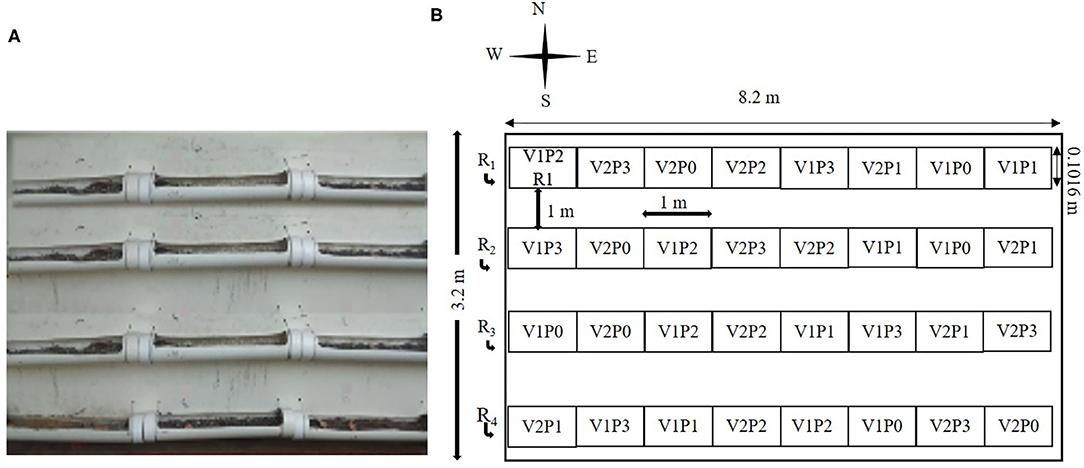
Figure 1. Containers and lay-out of the experimental set-up for vertically grown lettuce in a building wall, Dhaka city, Bangladesh. Two lettuce cultivars (Lactuca sativa cv. Green Wave, V1; Lactuca sativa cv. New Red Fire, V2) are grown in three different mixes of growing media (P0: control, 100% soil; P1: 40% soil + 40% vermicompost + 20% cocodust; P2: 50% soil + 50% vermicompost; P3: 20% soil + 40% vermicompost + 40% spent mushroom compost). (A) Partial view of growth device. (B) Schematic layout of experimental set-up.
Substrate Compositions
Four types of organic growing medium were applied, namely, 40% soil + 40% vermicompost + 20% cocodust (P1), 50% soil + 50% vermicompost (P2), and 20% soil + 40% vermicompost + 40% spent mushroom compost (P3) and 100% soil (P0, control). The chemical properties including organic carbon, nitrogen, C:N, P, K, and S of the different growing media are displayed in Table 1. Two lettuce cultivars, such as Green Wave (V1) and New Red Fire (V2) were used in this study. The study was carried out in a randomized complete block design (RCBD) with four replications (Figure 1B).
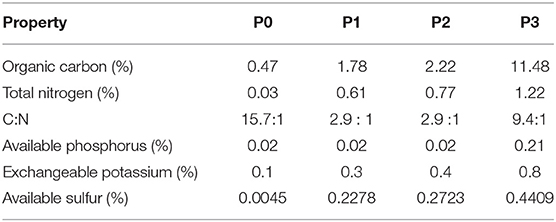
Table 1. Nutrient composition of the growing media (P0: control, 100% soil; P1: 40% soil + 40% vermicompost + 20% cocodust; P2: 50% soil + 50% vermicompost; P3: 20% soil + 40% vermicompost + 40% spent mushroom compost).
Plant Production
This study was conducted on the wall of the Horticultural farm building at the Sher-e-Bangla Agricultural University, Dhaka, Bangladesh from May to July 2019. Seeds of two lettuce cultivars those were Lactuca sativa cv. Green Wave (Lot No. 72 WN, Takii & Co. Ltd, Kyoto Japan) and Lactuca sativa cv. New Red Fire (Lot No. 96 WL, Takii & Co. Ltd, Kyoto Japan) put for germination in pots. Ten days old healthy and uniform sized lettuce seedlings were transplanted in a single row with 15 cm spacing in 1 m long growth devices, containing the organic substrates. The average temperature was 32.5–34.5°C (Table 2) and the relative humidity was 65.3–81.6% during the study. Transplanting as done in the afternoon and shade was provided by hanging a dense net over the wall until establishment of seedlings. All necessary intercultural operations, such as gap filling, weeding, and irrigation, were carried out accordingly. Total four hand weeding was conducted. Irrigation was provided as per evaporative demand of the plant (Once in every 2 days) with tap water. To avoid runoff of the irrigation water and leaching of nutrients into the lower devices, water was sprinkled on each device in two split doses (125 ml per container). A thin layer of foam as also provided at the bottom layer of each goring devices for the same reason. As part of the plant protection measures against pests (birds, insects, and thieves) the wall as covered with a coarsely woven net. There was no incidence of insect attack during the experiment. There was an infestation of Alternaria spp. in the lower leaf of plant, which was removed immediately and taken away. No additional plant nutrient was supplemented to the various organic substrates during this experiment. Lettuce was harvested at 40 days after transplanting and data were recorded.
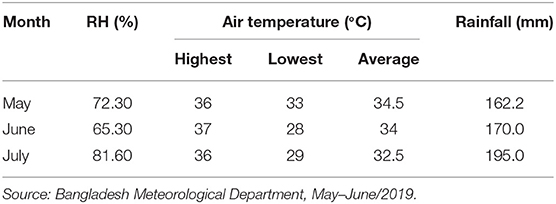
Table 2. Climate data reported during the experimental period from May to July 2019 were collected from Bangladesh Meteorological Department, Dhaka.
Analysis
Sensory Quality Test
Standardized organoleptic test was carried out to evaluate the sensory qualities, such as crispness, sweetness, bitterness, and appearance of lettuce leaf (Villared et al., 1979). In brief, a judge panel with 25 members was formed from the students and staffs of Sher-e-Bangla Agricultural university, Dhaka. Lettuce sample from different treatments along with questionnaire were served among the judges to evaluate the crispness, sweetness, bitterness, and appearance. Scoring was done on the three categories those were highly acceptable, slightly acceptable, and not acceptable. Finally, acceptability percentage was calculated.
Occurrence of Some Microbial Groups
Approximately, 10 g of fresh lettuce leaves from each sample was homogenized with 20 mL of distilled water in complete aseptic condition. Two sub-samples of this homogenate were taken separately, used for primary enrichment in Tryptic Soy Broth (TSB), and direct enumeration of fecal indicator bacteria (FIB) using selective bacteriological agar media using spread plate method (Sharp and Lyles, 1969; Siddiqee et al., 2013). These were McConkey Agar for total coliform count (TC), Hi-Chrome Agar for detection and enumeration of E. coli, Klebsiella spp., enterococci and Hi-Chrome Bacillus Agar Bacillus spp. All culture media were procured from Hi Media Laboratories Ltd., Mumbai, India. Sample was serially diluted with 0.9% NaCl. An aliquot of 100 μL was collected from the lettuce homogenate and spread on 90 mm plates containing solid media and incubated at 37°C for 24 h. Detection and enumeration of the presumptive colonies was based on characteristic colony appearances (Alippi and Abrahamovich, 2019).
For detection of Salmonella spp., aliquots of 5 mL lettuce homogenate were added to 45 mL TSB in 250 mL conical flasks for primary enrichment; the primary culture was incubated at 37°C for 12 h without shaking. After primary enrichment, ~10 μL aliquots for each of the samples were sub-cultured on Xylose-Lysine-Deoxycholate (XLD) agar media using streak plate method. The XLD plates were then incubated for 24 h at 37°C in aerobic conditions. Detections were made based on appearance of black center colonies with clear margins characteristic of Salmonella spp.
Economic Analysis
The economic analysis was done to find out the most economically viable treatment for lettuce cultivation. Economic analyses were done according to the procedure of Alam et al. (1989). In this method the cost of production of each treatment combination with four replications were calculated. The results were used to estimate the production cost of each treatment Same method was followed for estimation of the price of produces.
The cost of production consisted input cost and overhead cost. Installation cost, labor cost, material cost and irrigation cost comprised input cost. Installation cost of the experimental wall (8,960 BDT) was the most contributing sector in this study. Material cost included the cost of seed and manures as well as soil. Overhead cost comprised of interest on total input cost and miscellaneous cost. Interest on the experimental land price was excluded from overhead cost, since walls do not have economic value. Labor cost (300 BDT/day), interest on running capital for 2 months (13% annually) and value of the crop (750 BDT/kg) was considered according to local market. In the following steps the benefit-cost ratio was implemented.
Gross Return and Net Return
The gross return was determined by multiplying the marketable return by the lettuce unit price. Cutting out treatment—management costs from gross return measured net returns.
Benefit Cost Ratio (BCR) Calculation
The BCR was calculated according to the following formula:
Statistical Analysis
The mean values of parameters were statistically analyzed in Randomized Block Design using Analysis of Variance (ANOVA) technique in a computer program, Statistix 10 (Tallahassee, FL 32312, USA). The means were compared with Least Significant Difference (LSD) at 5% level of significance by Duncan's multiple range test.
Results and Discussions
Plant Growth Characteristics
Our study shows that, the composition of the growing medium has significant effect on the lettuce growth characteristics (Table 3). As expected, when no additional fertilizer (P0) was supplemented, the lettuce yield was low, irrespective of the cultivar (Figure 2). The plant height, leaf length, leaf width, leaf area, fresh and dry weight of the V1 and V2 lettuce was significantly increased in P1 with few exception among the treatments It is observed that V1 plant height was nearly double in P1 (34.88 cm) compared to P3 18.63 cm) and V2 has higher plant height in P0 (30.40 cm) compared to P3 (16.95 cm). At the same way, leaf area of V1 increased in P1 (397 cm) and lowest in P3 (263 cm) whereas, for V2, the highest leaf area was in P1 (286 cm) and lower in P3 (198 cm). Likewise, fresh and dry weight of the lettuce cultivars were increased in P1 substrate.

Table 3. Growth characteristics (plant height, cm; number of leaves per plant; leaf length, cm; leaf width, cm; leaf area, cm2; fresh and dry weight, g/plant) of two lettuce cultivars (Lactuca sativa cv. Green Wave, V1; Lactuca sativa cv. New Red Fire, V2) grown in different organic growing media (P0: control, 100% soil; P1: 40% soil + 40% vermicompost + 20% cocodust; P2: 50% soil + 50% vermicompost; P3: 20% soil + 40% vermicompost + 40% spent mushroom compost).
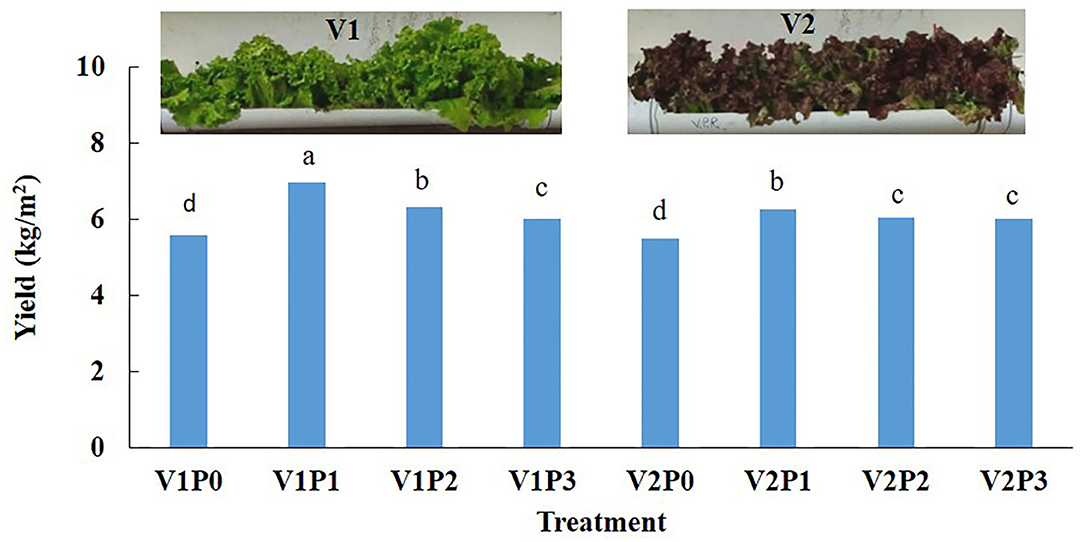
Figure 2. Yield of lettuce cultivars (Lactuca sativa cv. Green Wave, V1; Lactuca sativa cv. New Red Fire, V2) grown in different organic growing media (P0: control, 100% soil; P1: 40% soil + 40% vermicompost + 20% cocodust; P2: 50% soil + 50% vermicompost; P3: 20% soil + 40% vermicompost + 40% spent mushroom compost). The mean values with different letters are significantly different based on Duncan's Multiple rage Test (DMRT) at P < 5%.
It is well-known that, physical, chemical and microbiological parameters associated with growing media affect the agronomic performance of the grown crops (Santamaria et al., 2000; Boroujerdnia and Ansari, 2007; Islam et al., 2012; Tsiakaras et al., 2014; Jahan, 2017). Growing media or substrates include all materials that can be used to grow plants in a variety of production systems, such as greenhouse cultivation, containerized ornamental plant production, and urban agriculture (Cao et al., 2014). Vermicompost, cocodust, and others organic/inorganic components has been traditionally used as growing substrate (Méndez et al., 2011). However, a mixer of these organic and inorganic substances would be an excellent combination to improve the substrate physical and chemical properties. It is reported that a proper combination of different substrate enhanced the plant agronomic characteristics due to the optimal C/N ratios (Dumroese et al., 2011). The growing media constituents in the present study were chosen arbitrarily and not optimized with respect to the needs of a lettuce crop. Even though, the highest nutrient content was found when soil was amended with vermicompost and spent mushroom compost, about two times higher in N, P, and K (P3) than in the vermicompost-coir amended variant (P1), the higher growth attributes of both lettuce cultivars in substrate P1 might be due to the optimum bioavailable percentage of N, P, and K compared to P3. These findings prove that nutritional compositions in a growing medium are not only important factor for crop growth but should be rational percentage. The beneficial impact of coir on water holding capacity and porosity on plant biomass has previously been reported (Lokesha et al., 1988; Evans and Stamps, 1996).
In the framework of this proof of concept, we show that it is possible to grown leafy vegetables vertically on non-utilized building walls and that choice of growing medium composition and cultivar affects the agronomic performance. Our results also showed that the plant cultivar and growing medium is selective therefore, the cultivar and the growing medium properties must be adjusted to the specific plant variety/cultivar.
Sensory Quality
Sensory quality, such as crispness, sweetness, bitterness, and appearance of lettuce leaf influence its consumers' acceptance. The red-leafed cultivar V2 displayed the top and bottom score among the treatments in terms of crispiness, when grown in P1 and P0, respectively (Figure 3). The V2's sweetness was perceived as highly and slightly acceptable by all panel members. With the respect of sweetness, produce from V2P1 obtained highest acceptable score whereas V1P1 got highest unacceptable score. The highest acceptable appearance score was obtained by leaves from V2P1 treatment. However, the sensory quality taste results showed that crispiness, sweetness, and appearance of the red-leafed cultivar grown in the soil-vermicompost-coir mix was perceived higher than in all other treatments. The sensory quality including crispness and bitterness of leafy vegetables is greatly affected by the availability of the mineral in the growing medium (Gül et al., 2005). Other researcher also demonstrated that growing media has a significant control over the sensory attributes of leafy vegetables due to the varied physical and chemical properties of the substrate (Fontana et al., 2018). This emphasizes the need for adjustment of chemical and physical properties of the growing media to the crop's demand when aspiring sustainable urban food production.
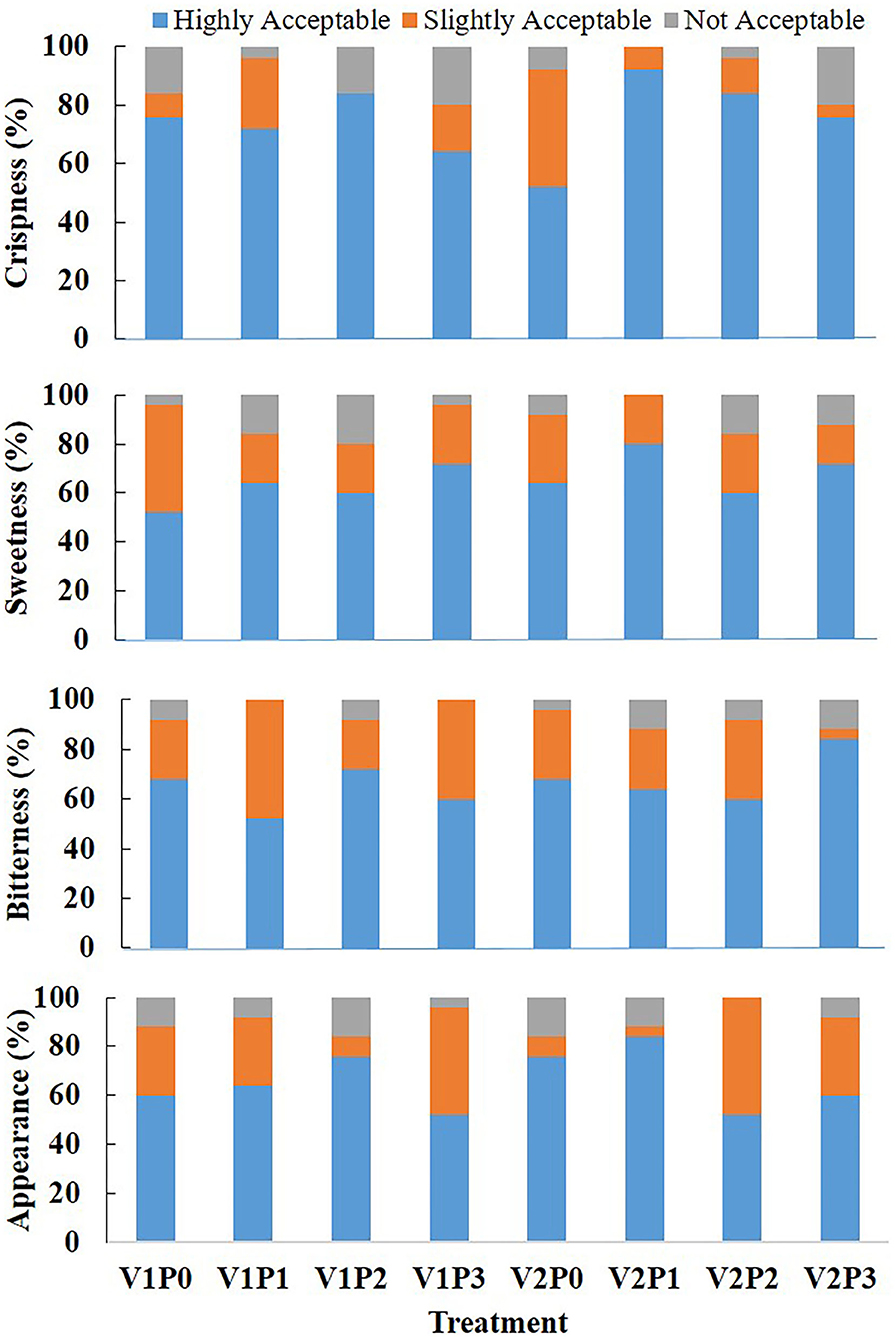
Figure 3. Sensory attributes of lettuce cultivars (Lactuca sativa cv. Green Wave, V1; Lactuca sativa cv. New Red Fire, V2) grown in different organic growing media (P0: control, 100% soil; P1: 40% soil + 40% vermicompost + 20% cocodust; P2: 50% soil + 50% vermicompost; P3: 20% soil + 40% vermicompost + 40% spent mushroom compost). A 25 members judge panel was formed to assess the sensory qualityies of lettuce (appearance, bitterness, sweetness, crispiness).
Occurrence of Microorganisms
It is reported that an enhanced consumption of fresh food is one of the reasons for increased number of foodborne outbreaks (Matthews, 2014). Usually, the outbreaks related to the fresh products are associated with pathogens, such as Salmonella, Listeria monocytogenes or pathogenic Escherichia coli (Heaton and Jones, 2008). Manures are widely used in organic farming, therefore, potentially, microbial contamination of organically grown plants may be higher than in conventional cultivation (Maffei et al., 2013). Consumers frequently consider that organic vegetables are better because they have less pesticide residues, but they ignore the microbiological safety issues resulting from organic production (Denis et al., 2016).
In the current study, none of the growing media showed a consistent picture when retention of the selected microbes was compared on the two cultivars (Table 4). Lettuce grown in the same growing medium, significantly lower CFU of the selected microbial groups were detected on the V2 cultivar as compared to the V1 cultivar, when grown in the P0, but considerably higher counts were found on the red-leafed than the green-leafed one, when the cultivars were grown in P2. Previously, it is noted that, plant growing in organic media is more prone to microbial infestation (Center for Science in the Public Interest, 2015). To produce safe ready-to-eat food, to assess risks and suggest hurdles, these factors must be clarified for future studies and uses. Despite the absence of Salmonella spp. in the present study, the high prevalence Enterobacteriaceae-genera is a concern. In food safety contexts, E. coli is used as an indicator organism, thus acting as a proxy for less abundant fecal contaminants (Yu et al., 2018). But the high prevalence of Klebsiella spp. in some of the treatments is disturbing from a food safety perspective. If such high numbers are an artifact or not, needs to be tested in future studies, considering standard food safety techniques and verification of presumptive colonies. To ensure that the urban produced ready-to-eat leafy greens are suitable for human consumption is a fundamental priority.

Table 4. Viable counts of selected bacterial organisms detected on leaves from two lettuce cultivars (Lactuca sativa cv. Green Wave, V1; Lactuca sativa cv. New Red Fire, V2) leaves grown in different organic growing media (P0: control, 100% soil; P1 : 40% soil + 40% vermicompost + 20% cocodust; P2: 50% soil + 50% vermicompost; P3: 20% soil + 40% vermicompost + 40% spent mushroom compost).
Economic Analysis
In the economic analysis, the cost benefit ratio was calculated in the Bangladesh context and the unit was expressed as Bangladeshi currency (BDT). After calculation, it is clearly shown that V1P1 has highest net economic return (4,619 BDT) having benefit cost ration (BCR) 1.37, whereas least economic return was attained at V1P3 combination having BCR 1.04 (Figure 4).
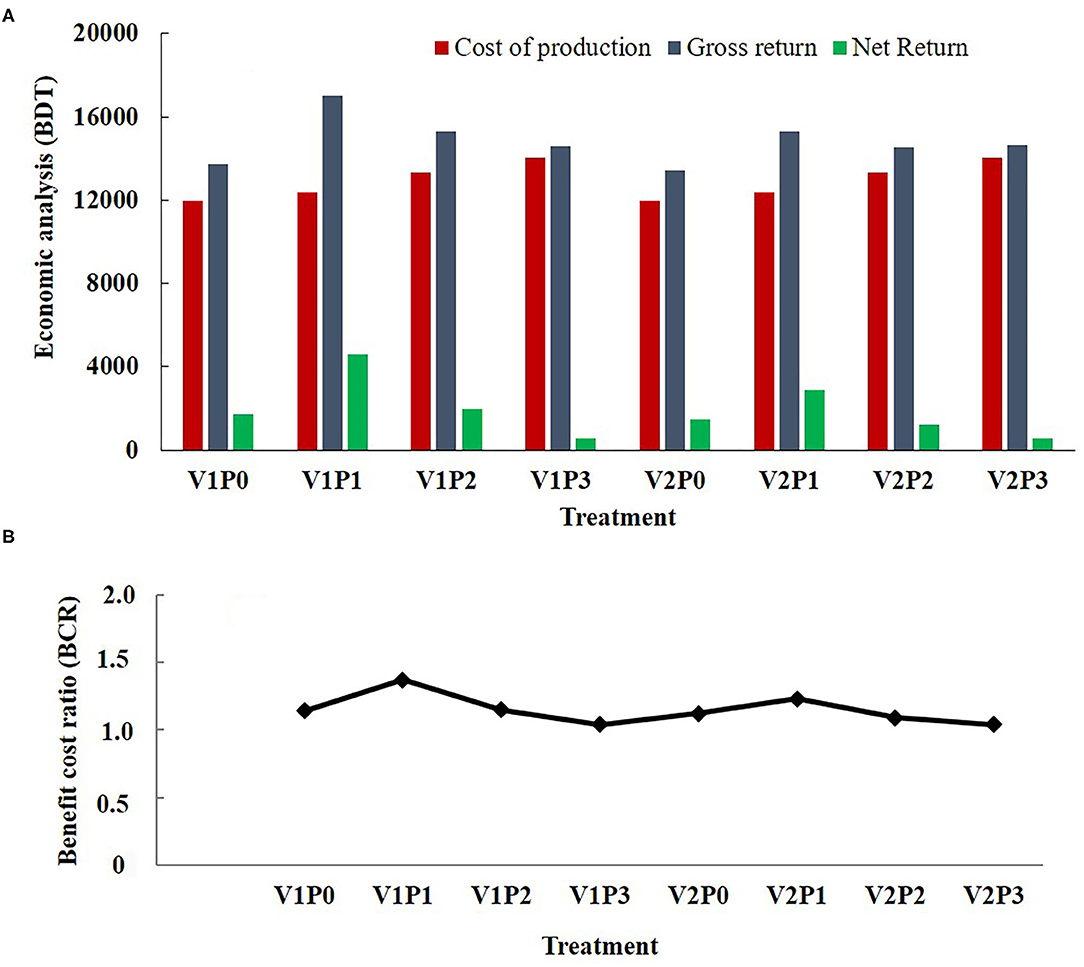
Figure 4. (A) Economic analysis and (B) Benefit cost ratio of two lettuce cultivars (Lactuca sativa cv. Green Wave, V1; Lactuca sativa cv. New Red Fire, V2) vertically grown in different organic growing media (P0: control, 100% soil; P1: 40% soil + 40% vermicompost + 20% cocodust; P2: 50% soil + 50% vermicompost; P3: 20% soil + 40% vermicompost + 40% spent mushroom compost) on the wall of a building in Dhaka City, Bangladesh.
In this experiment, the vertical garden was installed for 10 years and installation cost was 8,960 BDT. Since this amount will not be included in input cost after the first season; the garden will be economically more productive for further cultivation, at least by 8,960 BDT.
Cost reduction, effective production, and better quality produce increase the incentives of food productions in urban areas. However, high installation costs, labor cost in urban area are problems and need to be analyzed (Krusemana and Bade, 1998). Establishment costs for urban farm, their economic feasibility, and food–energy nexus are significant issues for food production system (Kan et al., 2018; Schlor et al., 2018).
In this research, it is seeking the application of techniques that assist the rural producers in obtaining greater monetary returns, encouraging them to continue in the agricultural activity in unutilized area. The ultimate net economic return is depending on the yield of the production. Higher yield of plant food is directly related to the economic thus ensure the production sustainability. Materials that are easily available and accessible to the local people, such as organic manure can be used as growing media (Vendruscolo et al., 2019).
Conclusion
Cities are thus of central importance for sustainable development and they are increasingly at the center of the food-energy nexus discussion. The direct interdependencies among those resources especially in urban areas, require an integrated approach for their management based on shared and jointly interpreted data. Current study provides important information, which could improve the scenarios of urban farming in densely populated urban areas in low-income countries with reuse of resources. It can be concluded that, this vertical farming was economically viable to produce safe vegetables. However, there is a considerable need to clarify the food safety situation of produce grown in densely populated areas.
Data Availability Statement
The original contributions presented in the study are included in the article/supplementary material, further inquiries can be directed to the corresponding author/s.
Author Contributions
MN: conceptualization. AS, MK, SA, and MN: methodology. RI, AS, MK, SA, MN, MS, MA, and BA: RI conducted experiment, data curation, and original draft preparation. All authors contributed to manuscript review, editing, and approved the submitting version.
Conflict of Interest
The authors declare that the research was conducted in the absence of any commercial or financial relationships that could be construed as a potential conflict of interest.
References
Alam, M. S., Iqbal, T. M. T., Amin, M., and Gaffar, M. A. (1989). Krishitattic Fasaler Utpadan O Unnayan (in Bengali). Sirajgonj: T. M. Jubair Bin Iqbal.
Alippi, A. M., and Abrahamovich, E. (2019). HiCrome Bacillus agar for presumptive identification of Bacillus and related species isolated from honey samples. Int. J. Food Microbiol. 305:108245. doi: 10.1016/j.ijfoodmicro.2019.108245
Al-Kodmany, K. (2016). Sustainable tall buildings: cases from the global south. Int. J. Archit. Res. 10, 52–66. doi: 10.26687/archnet-ijar.v10i2.1054
Alsanius, B. W., Jirström, M., Naznin, M. T., Khalil, S., and Ekström, E. C. (2020). “Optimizing horticulture for urban agriculture,” in Achieving Sustainable Urban Agriculture, ed I. J. S. C. Wiskerke (Cambridge: Burleigh Doods Science Publishing Limited), 1–57. doi: 10.19103/AS.2019.0063.15
Bass, B., and Baskaran, B. (2003). Evaluating Rooftop and Vertical Gardens as an Adaptation Strategy for Urban Areas. National Research Council, Canada
Boroujerdnia, M., and Ansari, N. A. (2007). Effect of different levels of nitrogen fertilizer and cultivars on growth, yield and yield components of Romaine lettuce (Lactuca sativa L.). Middle East. Russ. J. Plant Sci. Biotech. 1, 47–53. Available online at: https://www.scinapse.io/papers/2186752988
Cao, C. T. N., Farrell, C., Kristiansen, P. E., and Rayner, J. P. (2014). Biochar makes green roof substrates lighter and improves water supply to plants. Ecol. Eng. 7, 2018–2027. doi: 10.1016/j.ecoleng.2014.06.017
Center for Science in the Public Interest (2015). Outbreak Alert. A Review of Foodborne Illness in the U.S. From 2004–2013. Washington, DC: Center for Science in the Public Interest.
Centre for Food Safety (2014). Microbiological Guidelines for Food (For Ready-to-Eat Food in General and Specific Food Items). Hong Kong: Centre for Food Safety Food and Environmental Hygiene Department. Available online at: https://www.cfs.gov.hk/english/food_leg/files/food_leg_Microbiological_Guidelines_for_Food_e.pdf
Denis, N., Zhang, H., Leroux, A., Trudel, R., and Bietlot, H. (2016). Prevalence and trends of bacterial contamination in fresh fruits and vegetables sold at retail in Canada. Food Cont. 67, 225–234. doi: 10.1016/j.foodcont.2016.02.047
Despommier, D. (2013). Farming up the city: the rise of urban vertical farms. Trends Biotechnol. 31, 388–389. doi: 10.1016/j.tibtech.2013.03.008
Dumroese, R. K., Heiskanen, J., Englund, K., and Tervahauta, A. (2011). Pelleted biochar: chemical and physical properties show potential use as substrate in container nurseries. Biomass Bioenergy 35, 2018–2027. doi: 10.1016/j.biombioe.2011.01.053
Evans, M. R., and Stamps, R. H. (1996). Growth of bedding plants in sphagnum peat and coir dust-based substrates. J. Environ. Hortic. 14, 189–190. doi: 10.24266/0738-2898-14.4.187
Fallovo, C., Rouphael, Y., Rea, E., Battistelli, A., and Colla, G. (2009). Nutrient solution concentration and growing season affect yield and quality of Lactuca sativa L. var. acephala in floating raft culture. J. Sci. Food Agric. 89, 1682–1689. doi: 10.1002/jsfa.3641
Farag, A. A. A., Abdrabbo, M. A. A., and Abd-Elmoniem, E. M. (2013). Using different nitrogen and compost levels on lettuce grown in coconut fiber. J. Hortic. For. 5, 21–28. doi: 10.5897/JHF09.041
Fontana, L., Rossi, C. A., Hubinger, S. Z., Ferreira, M. D., Spoto, M. H. F., Sala, F. C., et al. (2018). Physicochemical characterization and sensory evaluation of lettuce cultivated in three growing systems. Hortic. Bras. 36, 020–026. doi: 10.1590/s0102-053620180104
Food Agriculture Organization (2013). Good Agricultural Practices for Greenhouse Vegetable Crops: Principles for Mediterranean Climate Areas. Roma: FAO. Available online at: http://www.fao.org/3/a-i3284e.pdf
Gül, A., Erogul, D., and Ongun, A. R. (2005). Comparison of the use of zeolite and perlite as substrate for crisp-head lettuce. Sci. Hortic. 106, 464–471. doi: 10.1016/j.scienta.2005.03.015
Heaton, J. C., and Jones, K. (2008). Microbial contamination of fruit and vegetables and the behaviour of enteropathogens in the phyllosphere: a review. J. Appl. Microbiol. 104, 613–626. doi: 10.1111/j.1365-2672.2007.03587.x
Islam, M. D. S., Ayesha, A., Shahin, M., Tusher, T. R., and Khanom, S. (2012). Effects of organic fertilizer on the growth and yield of lettuce (Lactuca sativa L.) used as vegetables. Int. J. Agric. Sci. Res. 2, 116–128.
Jahan, M. S. (2017). Effect of manure on growth and yield of three lettuce varieties (M.S. thesis), Sher-e-Bangla Agricultural University, Dhaka, Bangladesh.
Kan, G., Zhang, M., Liang, K., Wang, H., Jiang, Y., Li, J., et al. (2018). Improving water quantity simulation & forecasting to solve the energy-water-food nexus issue by using heterogeneous computing accelerated global optimization method. Appl. Energy 210, 420–433. doi: 10.1016/j.apenergy.2016.08.017
Krusemana, G., and Bade, J. (1998). Agrarian policies for sustainable land use: bio-economic modelling to assess the effectiveness of policy instruments. Agric. Syst. 58, 465–481. doi: 10.1016/S0308-521X(98)00041-9
Leon, A. P., Martín, J. P., and Chiesa, A. (2012). Vermicompost application and growth patterns of lettuce (Lactuca sativa L.). Agric. Trop. Subtrop. 45, 134–139. doi: 10.2478/v10295-012-0022-7
Lokesha, R., Mahishi, D. M., and Shivashankar, G. (1988). Studies on use of coconut coir dust as a rooting media. Curr. Res. 17, 157–158.
Maffei, D. F., de Arruda Silveira, N. F., and Catanozi, M. D. P. L. M. (2013). Microbiological quality of organic and conventional vegetables sold in Brazil. Food Control 29, 226–230. doi: 10.1016/j.foodcont.2012.06.013
Matthews, K. R. (2014). “Leafy vegetables,” in The Produce Contamination Problem. Causes and Solutions, 2nd Edn., eds G. M. Sapers, E. B. Solomon, K. R. Matthews (Academic Press), 187–206. doi: 10.1016/B978-0-12-404611-5.00009-9
Méndez, A., Barriga, S., Guerrero, F., and Gascó, G. (2011). Thermal analysis of growing media obtained from mixtures of paper mill waste materials and sewage sludge. J. Therm. Anal. Calorim. 104, 213–221. doi: 10.1007/s10973-010-1227-5
Mogren, L., Windstam, S., Boqvist, S., Vågsholm, I., Söderqvist, K., Rosberg, AK., et al. (2008). The hurdle approach–A holistic concept for controlling food safety risks associated with pathogenic bacterial contamination of leafy green vegetables. A review. Front. Microbiol. 9:1965. doi: 10.3389/fmicb.2018.01965
Mukherji, N., and Morales, A. (2010). Zoning for Urban Agriculture. Zoning Practice 3. Chicago, IL: American Planning Association. Available online at: https://metroomahafpc.files.wordpress.com/2014/05/zoning-for-urban-agriculture.pdf
Perini, K., and Novi, F. (2016). Is greening the building envelope a sustainable design practice? J. Civil Eng. Archit. 10, 661–666. doi: 10.17265/1934-7359/2016.06.004
Safayet, M., Arefin, M. F., and Hasan, M. M. U. (2017). Present practice and future prospect of rooftop farming in Dhaka city: a step towards urban sustainability. J. Urban Manage. 6, 56–65. doi: 10.1016/j.jum.2017.12.001
Santamaria, P., Generoso, C., Gonnella, M., and Elia, A. (2000). Yield and nitrate content of lettuce cultivars, Bologna, Italy. Edagricole. Colt. Protette 29, 71–77. Available online at: https://agris.fao.org/agris-search/search.do?recordID=IT2002060897
Schlor, H., Venghaus, S., and Hake, J. F. (2018). The FEW-Nexus city index—measuring urban resilience. Appl. Energy 210, 382–392. doi: 10.1016/j.apenergy.2017.02.026
Sharp, M. S., and Lyles, S. T. (1969). Laboratory Instruction in Biology of Microorganisms. St. Louis: CV Mosley Company.
Siddiqee, M., Islam, M. S., and Rahman, M. M. (2013). Assessment of pollution caused by tannery-waste and its impact on aquatic bacterial community in Hajaribag, Dhaka. Stamford J. Microbiol. 2, 20–23. doi: 10.3329/sjm.v2i1.15208
Siddique, M. M. A. (2017). Effect of organic farming on growth, yield and quality of lettuce and on soil properties (M.S. thesis), Bangladesh Agricultural University (BAU), Mymensingh, Bangladesh.
The United Nations (2017). World Population Prospects. The 2017 Revision. New York, NY: United Nations. Available online at: https://www.un.org/development/desa/publications/world-population-prospects-the-2017-revision.html
Timur, O. B., and Karaca, E. (2013). “Vertical gardens,” in Advances in Landscape Architecture (Intech Open), 588–662. doi: 10.5772/55763
Tsiakaras, G., Spyridon, A., Petropoulos, K., and Khah, E. M. (2014). Effect of GA3 and nitrogen on yield and marketability of lettuce (Lactuca sativa L.). Aust. J. Crop Sci. 8, 127–132. Available online at: http://www.cropj.com/tsiakaras_8_1_2014_127_132.pdf
Utami, S. N. H., and Jayadi, R. (2011). Vertical gardening for vegetables. Acta Hortic. 958, 195–202. doi: 10.17660/ActaHortic.2012.958.23
Vendruscolo, E. P., Alcântara, R. A. H., Correia, S. R., Oliveira, P. R., Cardoso, C. L. F., and Seleguini, A. (2019). Economic analysis of crisp lettuce production in different planting spacing and soil cover. Adv. Hortic. Sci. 33, 449–455. Available online at: https://oaj.fupress.net/index.php/ahs/article/view/8098
Villared, R. L., Tsou, S. C., Lai, S. H., and Chui, S. L. (1979). Selection criteria for eating quality in steamed sweet potato roots. J. Am. Soc. Hortic. Sci. 104, 31–33.
Wood, S., Sebastian, K., and Scherr, S. J. (2001). Pilot Analysis of Global Ecosystems: Agroecosystems. Washington, DC: International Food Policy Research Institute and World Resources Institute, 110. Available online at: http://www.wri.org/publication/pilot-analysis-global-ecosystems-agroecosystems (accessed September 23, 2019).
Work, P. (1997). “Vegetables production and marketing,” in Biotechnology Book (New York: J. Wiley & sons), 498.
Yakoot, M., Helmy, S., and Fawal, K. (2011). Pilot study of the efficacy and safety of lettuce seed oil in patients with sleep disorders. Int. J. Med. 4:451. doi: 10.2147/IJGM.S21529
Keywords: developing country, economic viability, food production, lettuce, microorganisms, sustainable green city
Citation: Islam R, Solaiman AHM, Kabir MH, Arefin SMA, Azad MOK, Siddiqee MH, Alsanius BW and Naznin MT (2021) Evaluation of Lettuce Growth, Yield, and Economic Viability Grown Vertically on Unutilized Building Wall in Dhaka City. Front. Sustain. Cities 3:582431. doi: 10.3389/frsc.2021.582431
Received: 06 August 2020; Accepted: 17 February 2021;
Published: 15 March 2021.
Edited by:
Thomas Rötzer, Technical University of Munich, GermanyReviewed by:
Akvile Virsile, Lithuanian Research Centre for Agriculture and Forestry, LithuaniaNurhidayati Nurhidayati, Universitas Islam Malang, Indonesia
Copyright © 2021 Islam, Solaiman, Kabir, Arefin, Azad, Siddiqee, Alsanius and Naznin. This is an open-access article distributed under the terms of the Creative Commons Attribution License (CC BY). The use, distribution or reproduction in other forums is permitted, provided the original author(s) and the copyright owner(s) are credited and that the original publication in this journal is cited, in accordance with accepted academic practice. No use, distribution or reproduction is permitted which does not comply with these terms.
*Correspondence: Most Tahera Naznin, bmF6bmluLm1vc3QudGFoZXJhQHNsdS5zZQ==
†These authors have contributed equally to this work
 Rinita Islam
Rinita Islam Abul Hasnat M. Solaiman
Abul Hasnat M. Solaiman Md. Humayun Kabir1
Md. Humayun Kabir1 Md. Obyedul Kalam Azad
Md. Obyedul Kalam Azad Beatrix W. Alsanius
Beatrix W. Alsanius Most Tahera Naznin
Most Tahera Naznin